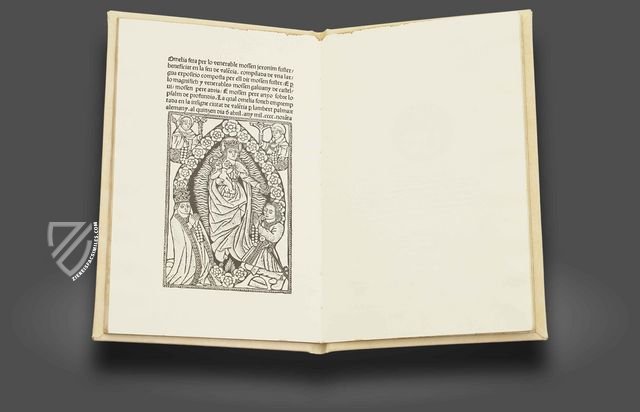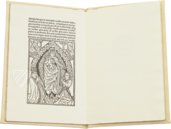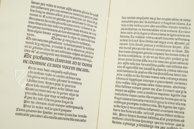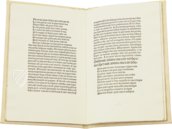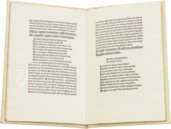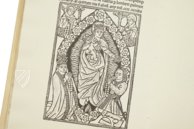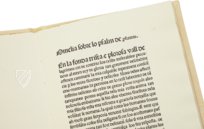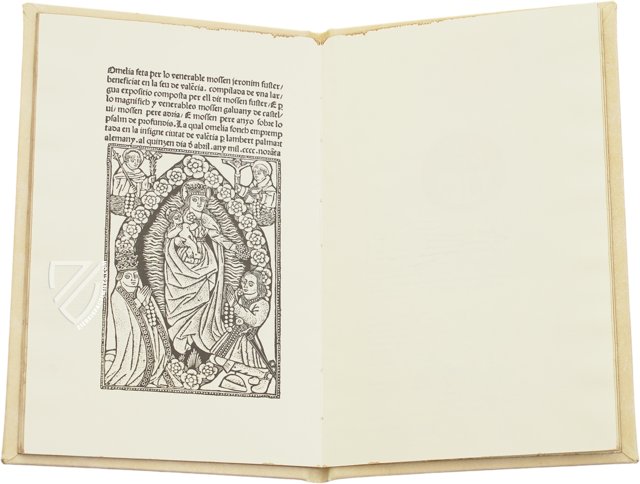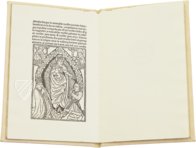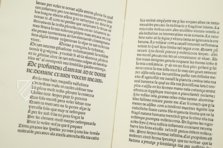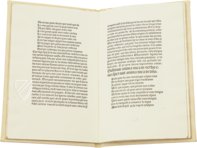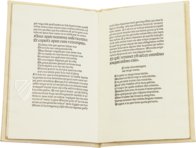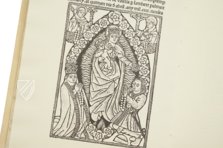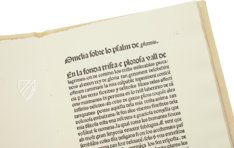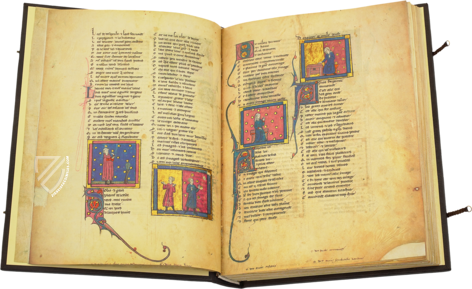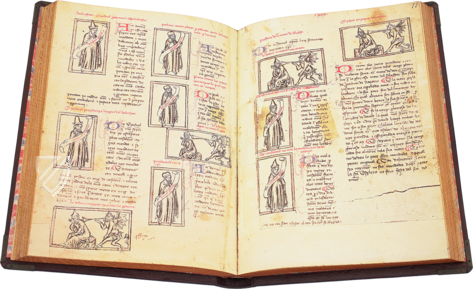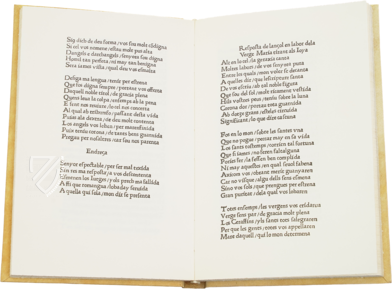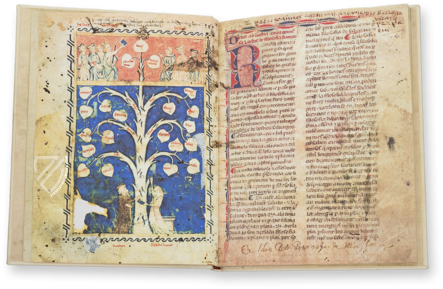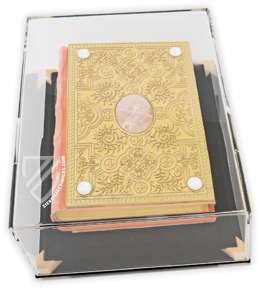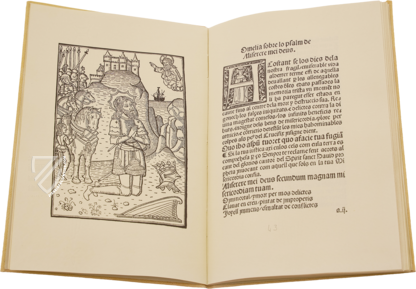Omelia sobre lo psalm "de profundis"
(under 1,000€)
This remarkable literary codex simultaneously demonstrates the influence of the Italian Renaissance in Spain while also presenting the first woodcut in the history of Spanish printing. The fine engraving depicting the Virgin of the Rosary and four other figures was created in Valencia, where the first Spanish printing press was erected. It adorns a homily by Jeroni Fuster concerning Psalm 130, often referred to as De profundis after its opening words in the Latin Vulgate, in which it appears as Psalm 129. Translating to “out of the depths”, the Psalm is a cry for mercy and a declaration of trust in God. The only surviving copy of the work printed on the 15th of April 1490 is preserved in the Historical Library of the University of Valencia and represent a real treasure of early Spanish book printing.
Omelia sobre lo psalm "de profundis"
A monument of Spanish book printing: the first Spanish woodcut, which originated in Valencia and depicts the Virgin of the Rosary flanked by two of the most important figures of the medieval church: an iris-wielding St. Dominic (1170–1221) and a book-wielding St. Thomas Aquinas (1225–74), while Pope Benedict III (d. 858) and a knight girt with a sword kneel at her feet – all four figures surrounding the Holy Virgin hold rosaries in their hands. This woodcut adorns a devout work in the style of an allegorical romance by Jeroni Fuster, partly in verse, which was printed in an elegant Gothic script. It was published by the Valencian printing house of Lambert Palmart (b. 1440) in 1490 and, according to M. de Riquer, was influenced by the Divine Comedy by Dante Alighieri (ca. 1265–1321). This incunabulum, a printed book predating 1501, is a fine testament to the genesis period of Spanish printing.
The Birth of Spanish Book Printing
After first emerging in the Mainz workshop of Johannes Gutenberg (ca. 1400–68) in 1452, the printing press and those with the knowledge to use them spread across Europe in the following decades. As a result, most of the first generation of printers were Germans. Spain’s first printing press was established in Valencia by a German trading company from Ravensburg in 1473. The man responsible for printing this codex, Lambert Palmart, appears to have been born in Cologne and studied at the Sorbonne in Paris before working in Valencia as a printer between 1474 and 1494. During that time, Palmart printed the first works in Valencian and Catalan respectively as well as printing the first work of literature in all of Spain.
The Only Surviving Copy
The only known copy of this incunabulum was bequeathed to the Historical Library of the University of Valencia by Vicente Hernández Máñez, who served as a librarian between 1852 and 1865. Jeroni Fuster’s homily is printed 28 lines per page in a Gothic typeface on 8 sheets without foliation and the engraving appears on the last page below the colophon, which includes the author, publisher, location, and date. It appears that the engraving predates the rest of the codex by three years and appeared in another work also concerned with the Virgin of the Rosary. Thus, this woodcut is considered the first to be used in Valencian incunabula. Little is known about the life of the author aside that he was a writer of poetry and prose with a master’s degree in theology and was a beneficiary of the Cathedral of Valencia. He participated in poetry contests in 1486 and 1511. His 1490 sermon is prose on Psalm 130 consists of two parts: the first section is allegorical and influenced by the Divine Comedy while the second is a gloss of the sixth Penitential Psalm.
Codicology
- Size / Format
- 24 pages / 23.5 × 15.0 cm
- Origin
- Spain
- Date
- 1490
- Epochs
- Genre
- Language
- Illustrations
- Woodcut of the Virgin Mary, flanked by St. Dominic and Thomas Aquinas
- Content
- Allegorical romance
- Artist / School
- Jeroni Fuster (author)
Lambert Palmart (printer)
Omelia sobre lo psalm "de profundis"
Madonna and Child
Crowned as Queen of Heaven, the Virgin Mary holds the baby Jesus as she stands in a mandorla – an almond-shaped aureola – filled with rays of light and lined with roses. Both figures also hold flowers in their hands. Pope Benedict III, crowned with the papal tiara, and a knight girded with a sword are kneeling in the foreground with rosary beads hanging from their hands, which are folded in prayer.
St. Dominic appears in the upper left corner holding his signature cross-staff and lilies while Thomas Aquinas holds a book and crucifix. Like the kneeling figures below, both the founder of the Dominican Order and the famous theologian hold rosaries in their hands. Dominic in particular is credited with spreading the Rosary and Marian devotion.
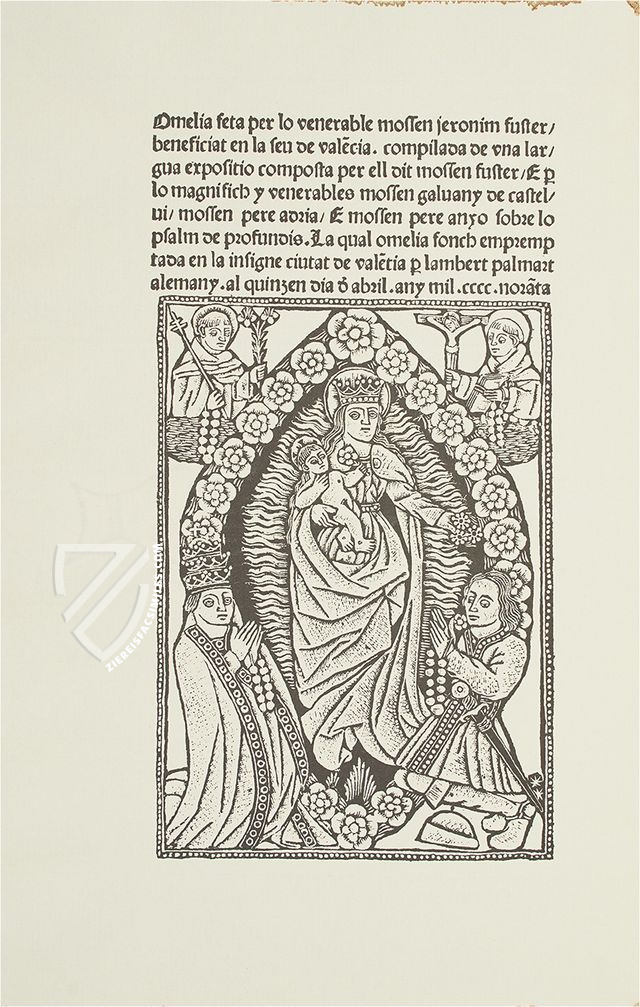
#1 Omelia sobre lo psalm "de profundis"
Language: Spanish
(under 1,000€)
- Treatises / Secular Books
- Apocalypses / Beatus
- Astronomy / Astrology
- Bestiaries
- Bibles / Gospels
- Chronicles / History / Law
- Geography / Maps
- Saints' Lives
- Islam / Oriental
- Judaism / Hebrew
- Single Leaf Collections
- Leonardo da Vinci
- Literature / Poetry
- Liturgical Manuscripts
- Medicine / Botany / Alchemy
- Music
- Mythology / Prophecies
- Psalters
- Other Religious Books
- Games / Hunting
- Private Devotion Books
- Other Genres
- Afghanistan
- Armenia
- Austria
- Belgium
- Belize
- Bosnia and Herzegovina
- China
- Colombia
- Costa Rica
- Croatia
- Cyprus
- Czech Republic
- Denmark
- Egypt
- El Salvador
- Ethiopia
- France
- Germany
- Greece
- Guatemala
- Honduras
- Hungary
- India
- Iran
- Iraq
- Israel
- Italy
- Japan
- Jordan
- Kazakhstan
- Kyrgyzstan
- Lebanon
- Liechtenstein
- Luxembourg
- Mexico
- Morocco
- Netherlands
- Palestine
- Panama
- Peru
- Poland
- Portugal
- Romania
- Russia
- Serbia
- Spain
- Sri Lanka
- Sweden
- Switzerland
- Syria
- Tajikistan
- Turkey
- Turkmenistan
- Ukraine
- United Kingdom
- United States
- Uzbekistan
- Vatican City
- A. Oosthoek, van Holkema & Warendorf
- Aboca Museum
- Ajuntament de Valencia
- Akademie Verlag
- Akademische Druck- u. Verlagsanstalt (ADEVA)
- Aldo Ausilio Editore - Bottega d’Erasmo
- Alecto Historical Editions
- Alkuin Verlag
- Almqvist & Wiksell
- Amilcare Pizzi
- Andreas & Andreas Verlagsbuchhandlung
- Archa 90
- Archiv Verlag
- Archivi Edizioni
- Arnold Verlag
- ARS
- Ars Magna
- ArtCodex
- AyN Ediciones
- Azimuth Editions
- Badenia Verlag
- Bärenreiter-Verlag
- Belser Verlag
- Belser Verlag / WK Wertkontor
- Benziger Verlag
- Bernardinum Wydawnictwo
- BiblioGemma
- Biblioteca Apostolica Vaticana (Vaticanstadt, Vaticanstadt)
- Bibliotheca Palatina Faksimile Verlag
- Bibliotheca Rara
- Boydell & Brewer
- Bramante Edizioni
- Bredius Genootschap
- Brepols Publishers
- British Library
- C. Weckesser
- Caixa Catalunya
- Canesi
- CAPSA, Ars Scriptoria
- Caratzas Brothers, Publishers
- Carus Verlag
- Casamassima Libri
- Centrum Cartographie Verlag GmbH
- Chavane Verlag
- Christian Brandstätter Verlag
- Circulo Cientifico
- Club Bibliófilo Versol
- Club du Livre
- CM Editores
- Collegium Graphicum
- Collezione Apocrifa Da Vinci
- Comissão Nacional para as Comemorações dos Descobrimentos Portugueses
- Coron Verlag
- Corvina
- CTHS
- D. S. Brewer
- Damon
- De Agostini/UTET
- De Nederlandsche Boekhandel
- De Schutter
- Deuschle & Stemmle
- Deutscher Verlag für Kunstwissenschaft
- DIAMM
- Droz
- E. Schreiber Graphische Kunstanstalten
- Ediciones Boreal
- Ediciones Grial
- Ediclube
- Edições Inapa
- Edilan
- Editalia
- Edition Deuschle
- Edition Georg Popp
- Edition Leipzig
- Edition Libri Illustri
- Editiones Reales Sitios S. L.
- Éditions de l'Oiseau Lyre
- Editions Medicina Rara
- Editorial Casariego
- Editorial Mintzoa
- Editrice Antenore
- Editrice Velar
- Edizioni Edison
- Egeria, S.L.
- Eikon Editores
- Electa
- Emery Walker Limited
- Enciclopèdia Catalana
- Eos-Verlag
- Ephesus Publishing
- Ernst Battenberg
- Eugrammia Press
- Extraordinary Editions
- Fackelverlag
- Facsimila Art & Edition
- Facsimile Editions Ltd.
- Facsimilia Art & Edition Ebert KG
- Faksimile Verlag
- Feuermann Verlag
- Folger Shakespeare Library
- Franco Cosimo Panini Editore
- Friedrich Wittig Verlag
- Fundación Hullera Vasco-Leonesa
- G. Braziller
- Gabriele Mazzotta Editore
- Gebr. Mann Verlag
- Gesellschaft für graphische Industrie
- Getty Research Institute
- Giovanni Domenico de Rossi
- Giunti Editore
- Graffiti
- Grafica European Center of Fine Arts
- Guido Pressler
- Guillermo Blazquez
- Gustav Kiepenheuer
- H. N. Abrams
- Harrassowitz
- Harvard University Press
- Helikon
- Hendrickson Publishers
- Henning Oppermann
- Herder Verlag
- Hes & De Graaf Publishers
- Hoepli
- Holbein-Verlag
- Houghton Library
- Hugo Schmidt Verlag
- Idion Verlag
- Il Bulino, edizioni d'arte
- ILte
- Imago
- Insel Verlag
- Insel-Verlag Anton Kippenberger
- Instituto de Estudios Altoaragoneses
- Instituto Nacional de Antropología e Historia
- Introligatornia Budnik Jerzy
- Istituto dell'Enciclopedia Italiana - Treccani
- Istituto Ellenico di Studi Bizantini e Postbizantini
- Istituto Geografico De Agostini
- Istituto Poligrafico e Zecca dello Stato
- Italarte Art Establishments
- Jan Thorbecke Verlag
- Johnson Reprint Corporation
- Josef Stocker
- Josef Stocker-Schmid
- Jugoslavija
- Karl W. Hiersemann
- Kasper Straube
- Kaydeda Ediciones
- Kindler Verlag / Coron Verlag
- Kodansha International Ltd.
- Konrad Kölbl Verlag
- Kurt Wolff Verlag
- La Liberia dello Stato
- La Linea Editrice
- La Meta Editore
- Lambert Schneider
- Landeskreditbank Baden-Württemberg
- Leo S. Olschki
- Les Incunables
- Liber Artis
- Library of Congress
- Libreria Musicale Italiana
- Lichtdruck
- Lito Immagine Editore
- Lumen Artis
- Lund Humphries
- M. Moleiro Editor
- Maison des Sciences de l'homme et de la société de Poitiers
- Manuscriptum
- Martinus Nijhoff
- Maruzen-Yushodo Co. Ltd.
- MASA
- Massada Publishers
- McGraw-Hill
- Metropolitan Museum of Art
- Militos
- Millennium Liber
- Müller & Schindler
- Nahar - Stavit
- Nahar and Steimatzky
- National Library of Wales
- Neri Pozza
- Nova Charta
- Oceanum Verlag
- Odeon
- Orbis Mediaevalis
- Orbis Pictus
- Österreichische Staatsdruckerei
- Oxford University Press
- Pageant Books
- Parzellers Buchverlag
- Patrimonio Ediciones
- Pattloch Verlag
- PIAF
- Pieper Verlag
- Plon-Nourrit et cie
- Poligrafiche Bolis
- Presses Universitaires de Strasbourg
- Prestel Verlag
- Princeton University Press
- Prisma Verlag
- Priuli & Verlucca, editori
- Pro Sport Verlag
- Propyläen Verlag
- Pytheas Books
- Quaternio Verlag Luzern
- Reales Sitios
- Recht-Verlag
- Reichert Verlag
- Reichsdruckerei
- Reprint Verlag
- Riehn & Reusch
- Roberto Vattori Editore
- Rosenkilde and Bagger
- Roxburghe Club
- Salerno Editrice
- Saltellus Press
- Sandoz
- Sarajevo Svjetlost
- Schöck ArtPrint Kft.
- Schulsinger Brothers
- Scolar Press
- Scrinium
- Scripta Maneant
- Scriptorium
- Shazar
- Siloé, arte y bibliofilia
- SISMEL - Edizioni del Galluzzo
- Sociedad Mexicana de Antropología
- Société des Bibliophiles & Iconophiles de Belgique
- Soncin Publishing
- Sorli Ediciones
- Stainer and Bell
- Studer
- Styria Verlag
- Sumptibus Pragopress
- Szegedi Tudomànyegyetem
- Taberna Libraria
- Tarshish Books
- Taschen
- Tempus Libri
- Testimonio Compañía Editorial
- Thames and Hudson
- The Clear Vue Publishing Partnership Limited
- The Facsimile Codex
- The Folio Society
- The Marquess of Normanby
- The Richard III and Yorkist History Trust
- Tip.Le.Co
- TouchArt
- TREC Publishing House
- TRI Publishing Co.
- Trident Editore
- Tuliba Collection
- Typis Regiae Officinae Polygraphicae
- Union Verlag Berlin
- Universidad de Granada
- University of California Press
- University of Chicago Press
- Urs Graf
- Vallecchi
- Van Wijnen
- VCH, Acta Humaniora
- VDI Verlag
- VEB Deutscher Verlag für Musik
- Verlag Anton Pustet / Andreas Verlag
- Verlag Bibliophile Drucke Josef Stocker
- Verlag der Münchner Drucke
- Verlag für Regionalgeschichte
- Verlag Styria
- Vicent Garcia Editores
- W. Turnowski Ltd.
- W. Turnowsky
- Waanders Printers
- Wiener Mechitharisten-Congregation (Wien, Österreich)
- Wissenschaftliche Buchgesellschaft
- Wissenschaftliche Verlagsgesellschaft
- Wydawnictwo Dolnoslaskie
- Xuntanza Editorial
- Zakład Narodowy
- Zollikofer AG

